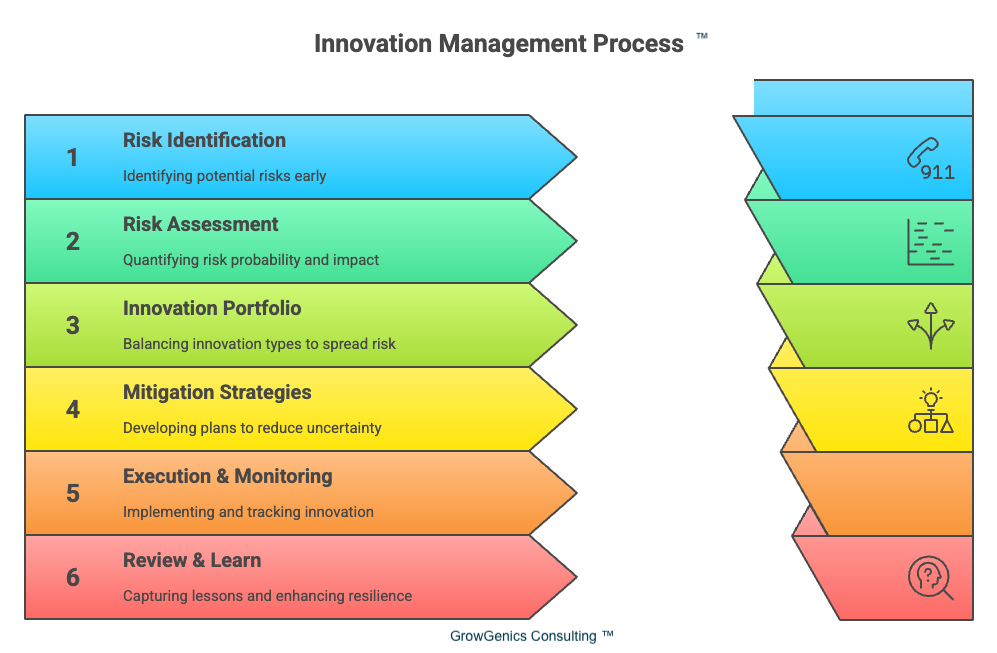
Strategic Innovation: Why Business Leaders Must Master Risk — Not Avoid It
Posted in :
In today’s rapidly evolving business world, steering a company sustainably requires more than calculated decisions—it requires risk-engineered strategy. Unlike reckless gambles, forward-thinking leaders seek to minimize uncertainty while maximizing upside, an approach vital for startups, SMEs, and even corporate giants competing against nimble newcomers.
Strategic Risk-Taking: Balancing Security with Growth
Traditionally, large enterprises have favored conservative strategies, driven by boards and stable revenue models.
Yet, in today’s entrepreneurial era, firms that cling too tightly to the status quo risk being disrupted by agile innovators. Successful leaders must redefine the balance between risk aversion and bold action.
Firms that strike a balance between risk and innovation are statistically better performers. Corporate foresight capabilities, which enable early detection of disruptions and informed adaptation, correlate with 33% higher profitability and 200% greater growth in market capitalization over seven years.
Why innovation reduces risk: Recent studies confirm that firms with higher R&D and innovation capability often experience lower volatility in performance and risk exposure—debunking the myth that innovation inherently escalates risk.
Several outcomes can be achieved by adapting this strategy, such as:
-
Organizations with mature foresight frameworks consistently outpace peers.
-
Risk-aware innovation reduces dependency on legacy models.
While some challenges can arise when adopting foresight, it is essential to understand that embedding foresight into strategy requires a cultural shift, which can be difficult to achieve in some companies. Additionally, the investment in foresight can often lack immediate ROI, and this can create significant resistance from stakeholders.
The Emergence of Agile Startups as Significant Competitive Threats
Today’s competitive landscape is increasingly shaped by small, agile entrants capable of rapidly disrupting entire sectors. The profound transformation of the advertising industry by Google within a single decade stands as a potent example of how cumulative startup innovation can systematically erode established industry paradigms and rulebooks. To proactively counter such threats, organizations should consider strategic structural adaptations, such as establishing disruptive subsidiaries dedicated to rapid, unencumbered innovation, and fostering internal incubation processes that liberate new ideas from bureaucratic constraints. However, a core challenge persists: entrenched corporate culture frequently resists innovations perceived as diluting focus or resources from the core business, creating a significant barrier to necessary adaptation.
Innovation Playbooks: Disruptive Subsidiaries, Skunkworks & Acquisitions
Disruptive Subsidiaries: Embedded within established firms but operating independently, these units foster radical innovation. Examples include ambitious spin-offs designed to explore tomorrow’s markets without jeopardizing core operations.
Skunkworks Teams: Inspired by Lockheed Martin’s WWII-era R&D unit, these autonomous, innovation-focused teams deliver breakthrough products—free from bureaucratic constraints.
Selective Acquisitions: This strategy accelerates innovation by importing technology and talent. Notable examples:
-
GM’s acquisition of Cruise Automation
-
Ford’s purchase of Argo AI
-
Toyota’s acquisition of Lyft’s self-driving unit
These moves demonstrate more than expansion—they indicate speed-to-market through strategic integration of advanced capabilities.
Overcoming Internal Resistance to Innovation
Organizations inherently resist change due to ingrained revenue models and risk aversion.
The imperative for continuous innovation is undeniable. Yet, established organizations frequently face a formidable, often self-imposed barrier: deeply ingrained internal resistance to transformative change.
Resistance often stems from:
-
Risk-aversion rooted in financial imperatives.
-
Short-term ROI pressures.
-
Lack of leadership understanding of transformative strategies.
Studies of enterprise risk appetite—like PwC’s survey—show that risk misalignment between boards and executive teams significantly hampers innovation readiness.
Strategic Solution:
-
Establish clear risk appetite frameworks.
-
Develop leadership capability to discuss risk as a strategic tool, not a threat.
This resistance comes from powerful, structural sources—entrenched revenue models that prioritize short-term stability, pervasive risk aversion cultivated by legacy success, and significant cultural and structural inertia. Can lead to unwanted consequences, such as a systemic tendency, well-documented by research, for hierarchical firms to unconsciously filter out truly disruptive ideas. Bold concepts promising fundamental change are routinely diluted into safer, incremental improvements, leaving organizations vulnerable to more agile competitors. Overcoming this resistance, therefore, demands more than just novel processes or frameworks; it requires a fundamental shift in organizational mindset. True innovation thrives only when risk is reconceptualized from a paralyzing constraint into a strategically managed catalyst for growth. Addressing this internal friction is not merely an operational challenge; it is a critical strategic priority for any organization seeking to secure its future relevance and competitive advantage.
| Strategy | Benefits | Key Risks |
|---|---|---|
| Disruptive Subsidiaries | Rapid innovation, competitive repositioning | Cultural isolation, integration challenges |
| Skunkworks Teams | High creativity, fast decision cycles | Re-integration hurdles, organizational silos |
| Acquisitions | Speed to capability, access to new talent | Innovation decline if integration poorly managed |
| Foresight & Risk Alignment | Elevated returns, agility, future-readiness | Requires leadership maturity and long-term vision |

Research-Backed Insights: When Risk Leads to Resilient Innovation
-
CEO Risk Appetite & Innovation: According to Lavie and Klarner (2022), a CEO’s innate risk propensity promotes innovation only if they possess enough internal influence, face competitive pressure, and the firm doesn’t already dominate exploration.
-
Innovation Efficiency: Chinese firms with strong innovation input and output show better risk-adjusted performance. Yet, high risk-taking without innovation efficiency can impede long-term development.
-
Environmental Uncertainty & Innovation: Firms facing climate or regulatory unpredictability may delay innovation. However, strong governance and market support can neutralize this effect.
Adapt or Fade
Innovation isn’t just an option—it’s a survival strategy.
Leaders who balance risk-informed innovation with structural agility thrive, while those clinging to predictability lag.
Key strategies for forward momentum:
-
Establish autonomous innovation units (subsidiaries, skunkworks)
-
Make smart acquisitions to accelerate capability
-
Foster innovation-supportive culture and governance
-
Align leader risk profile with firm objectives
The choice is simple: embrace measured risk or prepare to be outmaneuvered.

Fostering Innovative Thinking
At GrowGenics Consulting, we aim to promote a culture where innovation thrives. We believe in creating an environment where every voice matters and every idea has potential.
We encourage our Clients to think creatively and challenge the status quo. Learning and growth should be embedded in their mission, as we equip the leadership and teams with the tools they need to adapt and excel in changing landscapes. Every achievement is celebrated, and every setback is viewed as a learning experience that leads to future success.


